
Penh Folds – The Four Wines of Destiny
“The Ox is slow but the Earth is Patient”
Confucius
The recent Spring Festival and Lunar New Year heralded in the arrival of the year of the Iron Ox, 2021.
The metal element being one of the heavenly stems of the Wuxing, which is a philosophy that informs Chinese astrological traditions and beliefs. It encompasses the “Five Phases”, which are Fire (火 huǒ), Water (水 shuǐ), Wood (木 mù), Metal (金 jīn), and Earth (土 tǔ).
In Taoist thought, metal attributes are firmness, rigidity, persistence, strength, and determination. People born under this element are seen as having the following traits: self-reliant, strong willed, hardworking, stoic. However, as gold is a metal, they are also known to be capable of appreciating luxury and enjoying the finer things in life. Metal people are famously patient, honest, strong willed and courageous.
In Taoist creation theory, there are ‘The Four Mythical Beasts’; the Azure Dragon of the North, the Vermillion Bird of the South, the White Tiger of the West and the Black Tortoise of the East. The metal element is associated with the direction West, the season of autumn and the white tiger, Jian Bing. The earliest known reference to these mythical creatures was discovered in 1987, in a tomb in Henan province in China that has been dated to 5,300 years BCE.
There are twelve animals in the Chinese ‘zodiac’ one for each year of a twelve-year cycle. Of the 12 year cycle the first year belongs to the rat, followed by the ox, then the tiger, rabbit, dragon, snake, horse, goat, monkey, rooster, dog and finally the pig.
The Creation legend has it that the Jade Emperor -in order to help his people navigate life’s difficult maze- decided to create a zodiac as a sort of guiding compass; in which he would assign an animal to each sign of the zodiac. An announcement went out to all the animals that there would be a race; the first 12 beasts to cross the finish line would become the signs of all future human character and destiny.

On the eve of the race thirteen animals showed up ready to take part, they went to sleep early in order to be fresh for the morning start. The Ox woke suddenly in the middle of the night and -knowing that he was slow- decided to set off there and then, in order to gain a considerable head start. In his clumsiness, the Ox woke both the rat and the cat, who decided to join him for their own safety. The pair scurried ahead, climbed a tree and as the Ox passed underneath, they gently dropped themselves onto his back, the Ox was none the wiser.
Whilst the dragon slept heavily the other animals awoke and quickly, but quietly sped off after the three earlier starters. Try as they might, they could not seem to make up enough ground to catch the determined Ox. When the dragon finally woke, he peered around the camp and upon noticing that everyone else had already left, he remained calm and was unconcerned. The dragon was comfortable in the knowledge that he alone had the power of flight.
The dragon soared though the air, quickly caught up to the pack and then overtook the other racers. Just then, he saw a village surrounded by fire and (being a benevolent soul), did not hesitate to divert his path in order to go help save it. At that moment his race was lost.
As the Ox eventually neared the final stretch, he and his passengers came to a large river. This river was wide and had a strong current and the Ox could see that it would have to be crossed before finally reaching the finish line, on the other side. The Ox was not worried, he knew he was a strong swimmer however, his passengers were not so comfortable. Poor swimmers, when cat and the rat saw the river they were soon both shaking in fear and huddled for safety in the center of the Ox’s back, as the powerful beast waded out into deeper waters.
The Ox thought he was still comfortably ahead of every other animal as he resolutely leaned against the current and reached the midway point of the river. It was at that moment the cunning rat, (knowing the cat was not a good swimmer) leapt up and pushed his fellow stowaway into the water. The cat flailed about in panic and was quickly swept away down river.
Unperturbed, the Ox emerged from the river and meandered up to the finish line, pausing briefly he turned his head to peer behind, so as to make sure he was still well clear of his rivals. The Ox was pleased with what he saw and took a moment to congratulate himself on how well his simple plan had worked.
Seizing the opportunity, in that split second the rat leapt from the Ox’s back with all its might and scurried over the finish line -cementing its place at the head of the cycle for all eternity.
The enraged Ox soon followed, resigned to history in second place. Next to cross was the powerful Tiger, followed by the Rabbit -who was apparently pushed to shore by a helping puff of breath from the Dragon, who followed next. The snake -who was by now sneakily hiding in the Horse’s mane- slithered across in sixth place, just in front of Horse. The Goat, Monkey and Rooster -who had worked together as a team to cross the river- then crossed the line in that order. Finally, after a long bath and a bit of a play in the river, the Dog emerged and claimed the eleventh spot and lastly came the Pig, who crossed the river only after a lavish meal and a short nap.
The cat, having been washed far downstream, eventually made its way back up to the finished line, crossing in 13th place and missing a spot in the zodiac. This is said to be why cats hate rats and will chase them endlessly until the end of days. (Source: Traditional Chinese Medicine World Foundation.) Note that another popular legend has it that the Rat, seeing the cat was far more attractive, simply elected not to wake him up.

Lord of the Stove
Siming, 司命 is the Chinese god of destiny and it is said that this role entails making fine adjustments to human fate, including their lifespan. As a stellar constellation, Siming is associated with the Wenchang Wang star pattern in Aquarius, which is in the northern quadrant of the sky, symbolized by the black tortoise of the north. Of shamanistic origins, Siming is sometimes known as, (or merged with) Zaojun, the lord of the kitchen, or more specifically, 灶君 Lord of the Stove. In some instances, he is given the full title: Dongchu Siming Dingfu Zaojun, (Lord of the Stove of the Eastern Kitchen that Controls Destiny and Determines Fortune).
The King of Culture
Wenchang Wang 文昌王 is the Taoist god of culture and literature and his name can be translated as ‘King of Culture/Language. Wenchang has historically been called upon by scholars and writers who need inspiration or help right before an exam, this was especially so for the Imperial examination.
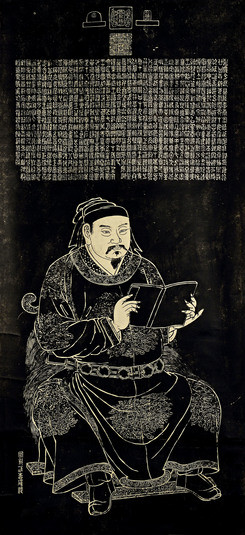
The practice of worshiping Wenchang Wang has a long history; it was popular in the past because he was allowed to be venerated by the rich and poor alike and he is still worshiped to this day, for essentially the same reasons. When at temple, as well as making offerings and sacrifices in his name, worshippers will often recite poetry.
“In the midst of chaos, there is also opportunity.”
Sun Tzu
Zhan Liang
On the auspicious occasion of the 10th of the 2nd of 2021, in the midst of covid, a coup and more than one crisis in my life, Siming the Chinese god of the ‘kitchen of destiny’ and of good fortune; along with Wenchang Wang, the god of culture and literature, smiled down upon this humble man of wine and letters. For I had received an invitation to dine at my favourite Chinese restaurant in all Cambodia, with my favourite sommelier, to present 20 auspicious guests with Australia’s most renowned and internationally celebrated wines.
Zhan Liang -underneath the Rosewood Hotel in Phnom Penh- is always an exceptional gastronomic experience. The magnificent interior design a perfect auditorium to present the exciting, adventurous and highly accomplished culinary skills of head chef David Pang paired with the highly polished charm, elegance, understanding and aristology of sommelier and restaurant manager Eden Gnean.
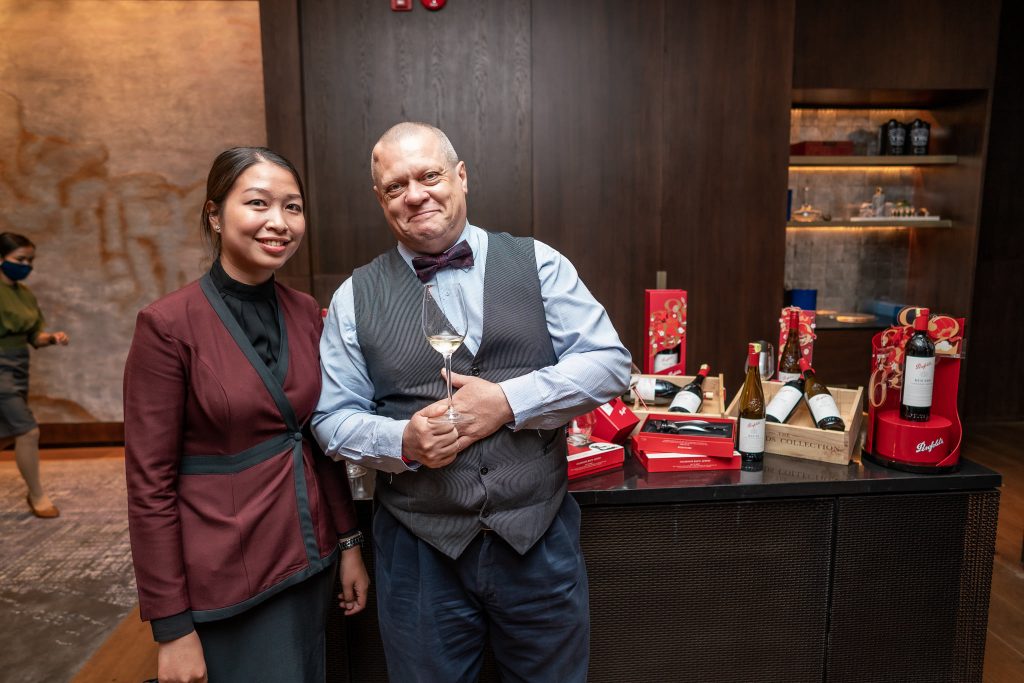
The food here is exquisite: creative interpretations of classic Cantonese, Sichuan and Northern Chinese dishes, incorporating Pang’s global experience -cooking in some of the world’s most progressive Chinese kitchens- with local ingredients, provisions and culinary lore.
Eden Gnean is an exceptional restaurant manager, who has created a wonderful service experience with her team here. As Cambodia’s foremost sommelier, Eden’s wine list is extensive, full of exciting and inspiring wine choices. Any visit to Zhan Liang to savor Pang’s food, is matched by that little tingle of excitement one gets when you see what new wines Eden is serving by the glass, or recommending with your food.
For more of my meditations on this subterranean siheyuan of succulence, click here: www.vindochine.com/2020/12/10/the-chinese-lantern-under-a-bushel/.

‘1844 to Evermore!’
Penfolds vast wine empire was founded by a young English doctor, who migrated to one of his country’s most distant colonies, over a century and a half ago. ‘From a soil that had never grown grapes and winemakers that had never made wine, came the very first bottles of Penfolds’ as the story goes.
In 1844, Dr Christopher and Mary Penfold arrived in the new world onboard the ‘Taglioni’, with a vine cutting and a bold vision. Dr Penfold was born in 1811, the youngest of 11 children; he studied medicine at St Bartholomew’s Hospital, London, graduating in 1838. In 1844, he and his wife Mary purchased the Magill, (originally “Mackgill”) Estate, “comprising 500 acres of the choicest land.”
By all accounts, it was Mary Penfold who was responsible for the management and early winemaking duties at the fledgling wine estate. Initially, the wines were prescribed as tonics for the Doctor’s patients, the famous Penfolds slogan ‘1844 to evermore’ harks back to these origins.
By 1870, the ‘Grange’ vineyard encompassed over 60 acres with several different grape varieties including Grenache, Verdelho, Mataro (Mourvèdre), Frontignac and Pedro Ximenez. The estate was producing both sweet and dry red wine and white table wines, with a growing market in the eastern Australian colonies of Victoria and New South Wales.
A catalogue from 1889, lists wines from the Grange and Magill vineyards as Mataro, Grenache, Constantia, Grange Port, Frontignac, Grange Tawny, Pedro Ximenes, Tokay, Madeira, Grange Sherry and Muscadine. The catalogue adds: “We have also light red and white dinner wines of claret and Riesling types, suitable for use in Clubs.”
Penfolds and Co. – the newly formed partnership of Mary Penfold and her son-in-law Thomas Hyland and her cellar manager Joseph Gillard – now claimed to be producing over one-third of South Australia’s wine. Mary Penfold passed away in 1896 after a remarkable contribution to Australia’s wine industry.
Fortified wine production dominated the industry throughout the first part of the 1900s and Penfolds gained a strong reputation for its fortified wines during the 1920s and ‘30s. Between the world wars the market for fine table wine in Australia was extremely limited. Penfolds did, however, produce an ‘Italian Red’ for Italian migrants working the cane fields of Queensland.
In 1943, Penfolds acquired the highly regarded and valuable Auldana Vineyard and winery – adjacent to the Magill vineyard. In 1945, Penfolds purchased the Kalimna Vineyard in the Barossa Valley – at this time the largest vineyard in South Australia. By the late 1940s Penfolds had acquired or planted vineyards in McLaren Vale, Griffith, the Hunter Valley and Minchinbury.
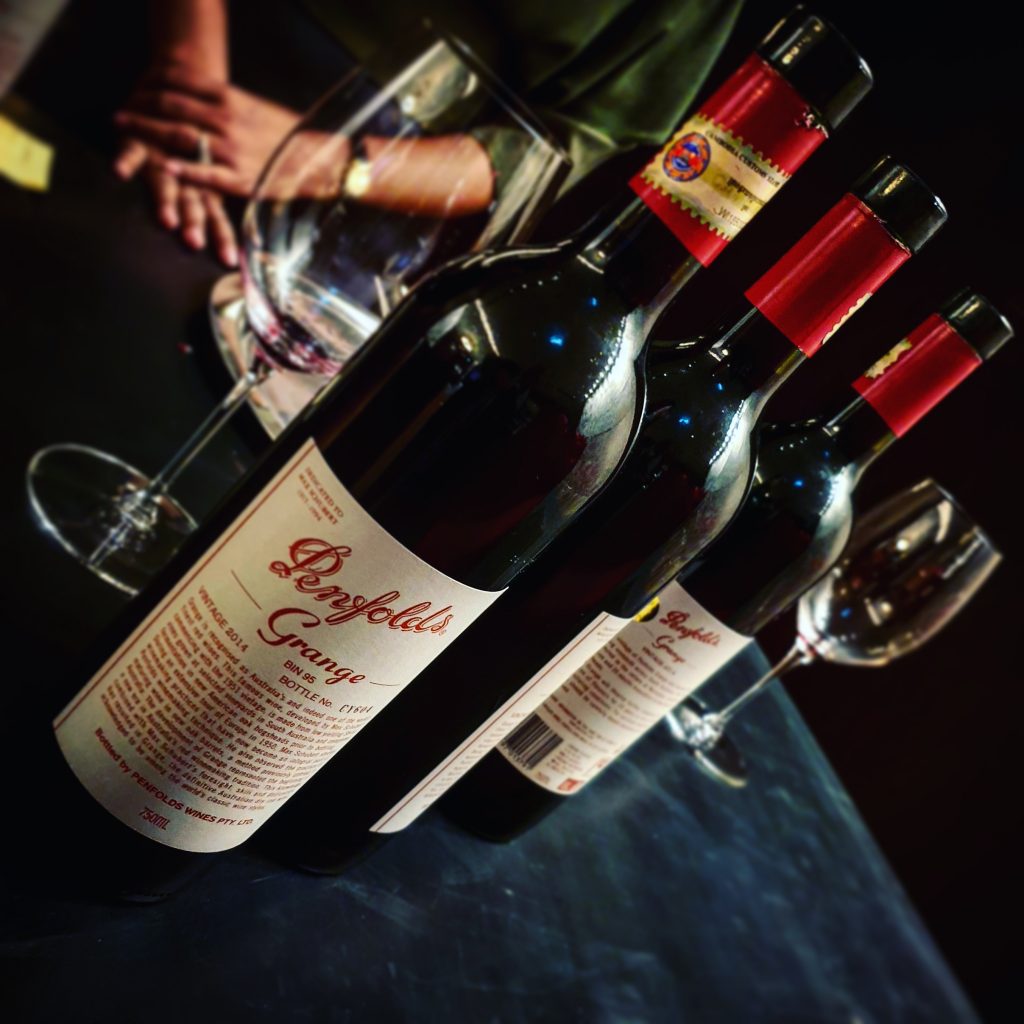
Grange
Max Schubert joined the company in 1931 as a 16-year-old messenger boy, by 1948 he was chief winemaker at just 33 years old, a position he would hold for almost 30 years.
In 1949, following WW2, Schubert was sent to France and Spain to learn about fortified winemaking but, whilst there he fell in love with the dry, full bodied, long lived red wines he discovered on a side trip to Bordeaux. When he returned to South Australia Schubert set about attempting to create Australia’s great full-bodied, dry red wine with the ability to age.
The first vintage produced was a small amount of wine from the 1951 vintage, when it was finally bottled and shown to critics in 1957 they hated it. Also in 1957, the 1952 vintage was the first commercial release of the wine, which Schubert called “Grange”, it was made with 100% Shiraz. This too did not receive a favourable reception, roundly panned by the wine critics of the day.
As Max himself put it “The results were disastrous.” One well known wine critic made the following remark “Schubert, I congratulate you. A very good dry port, which no one in their right mind will ever buy, let alone drink.”

It was then that the pioneering winemaker was ordered by Penfolds’ board of management to cease and desist.
Thankfully, Schubert ignored these instructions from on high, hid the existing stock and continued to produce the wine in 1957, 1958 and 1959, which are today known as the ‘Secret Granges’.
The 1951’s that survive today are rare, never commercially released they are almost impossible to find, until the odd one pops up at Auction, the most recent example being in 2020, where it fetched AUD$ 103,000 for a single bottle of the wine. In 2019 a collection of one bottle of every Grange from 1951 to 2015 fetched AUD$372,000 at an auction in Australia.
By the time of the 1955 vintage, Max Schubert was starting to understand the vineyards and the winemaking required and he was really hitting his straps. Once the wine was mature enough and now with 10% Cabernet Sauvignon added to the blend, reviews internally (by the board of directors and their trusted wine critics) where more favourable. So much so, that in 1960 Schubert was once again given license to commence with project ‘Grange’.
By 1962, the board at Penfolds were confident enough to enter the wine into the wine show circuit, it won a gold medal in the Royal Sydney Wine Show ‘Open Claret’ class, which pleased Max greatly, as some of the judges were the very same that had roundly criticized the wine and its style earlier on.
The 1955 remains the most decorated Grange in history, with 12 trophies and 52 gold medals, indeed legend has it that Penfolds had to ‘retire’ the wine from the show circuit, in order to give some of their other wines a chance at winning some of the gold!
With renewed endeavor, Schubert oversaw the creation of a series of new, fuller bodied, dry red wines, wines that had begun as a part of his initial project and would go on to become great and eventually iconic wines in their own right: Bin 389, Bin 707, Bin 28 and Bin 128. These are wines that may differ in character from year to year, but bear an unmistakable resemblance to each other. The backbone of Penfolds’ red wine portfolio and their inimitable, ‘house style’. The famous ‘Bins’ getting their names from their initial ‘Batch Identification Number’, which would signify where they would be stored in the vast cellars.
There have only been three other winemakers to be charged with crafting vintages of Penfolds Grange, since the retirement of Max Schubert in 1976. Maxed passed the role on to Don Ditter who stayed in the until 1986, then it was the turn of John Duval until 2002, when the torch was passed on to veteran oenologist and former Penfolds chief development winemaker, Peter Gago. Peter’s very successful stint in the role continues and, both his Penfolds wines and he as a winemaker have become two of the most famous wine entities in the world today.

Penfolds is the only Australian Winery to receive 100 points from both Wine Spectator (US) and Robert Parker’s Wine Advocate (US) for the same Vintage (2008 Grange). In 2017, Grange was classified as a First Growth in Liv-ex’s published recreation of the Bordeaux 1855 classification. Other notable accolades include:
100 Points from Lisa Perrotti-Brown, Wine Advocate for Grange 2013
100 Points from Andrew Caillard MW for Grange 2012
100 Points from Tyson Stelzer for Grange 2010
Wine Spectator’s Red Wine of the Year 1995 for Grange 1990
100 Points from Tastingbook for Grange 1986
100 Points from Robert Parker’s Wine Advocate for Grange 1976
20/20 Points from Jancis Robinson for Grange 1953
First prize in Winestate’s World’s Greatest Shiraz and Syrah Challenge 2018
In August of 1995, Robert Parker, the world’s most influential wine critic, wrote in his self-published newsletter The Wine Advocate that Grange was “a leading candidate for the richest, most concentrated dry table wine on planet earth.” The acceptance of Grange as a great Australian wine had proved that Australia is capable of producing wines equal to the best in the world.
Nature does not hurry, yet everything is accomplished.
Lao Tzu

The Chemist
Another name that must be mentioned in the pantheon of Grange wine greats is Ray Beckwith, who was a winemaker at Penfolds in the 1930’s and 40’s and lived to the ripe old age of 100. He was Penfolds’ first trained chemist and is credited as the first winemaker in Australia and perhaps the world to understand how pH control could save wine from being ruined by microbial disease.
After first seeing a pH meter at an Adelaide university, Beckwith persuaded Penfolds to buy one. The cost was equal to 20 weeks of his own salary. It was the first used in a winery in Australia, probably the world. His genius saved Penfolds a massive amount of money by preventing microbiological spoilage. Wines with high pH levels are prone to bacterial spoilage, Beckwith realized that by adding tartaric acidity to lower the pH solved the problem. It is still the most common way to control pH in wine to this day.
His work is credited with enabling Penfolds’ chief winemaker, Max Schubert, to create Australia’s most famous wine, Penfolds Grange.
Due to much of his work being hidden from the competition under confidentiality and ‘trade secrets’ rules of the day, few knew of the important role Beckwith played in the quality of Penfolds wines and its ability to produce red wines the caliber of Grange and the Bins.
Beckwirth retired from Penfolds in 1973 and Max Schubert himself didn’t sing Ray’s praises until after he himself had retired in 1976. It was the investigative and thorough work of wine journalist, judge, critic and writer, Huon Hooke who uncovered the full story of Beckwirth’s unique and vaunted place in Australia’s wine history.
Ray Beckwith’s achievement was only recognized later in his life, with an honorary doctorate from Adelaide University in 2004, in recognition of his contribution to wine science, the highly regarded Maurice O’Shea Award in 2006, and the Medal of the Order of Australia in 2008.
Roads and developments in the Barossa Valley are now named after him. He was also made a life member of the Winemakers’ Federation of Australia, and an honorary life member of the American Society of Viticulture and Oenology.
Phnom Penh Folds
So it was, that on the occasion of Chinese New Year 2021 in Phnom Penh, Cambodia, I found myself presenting some of Australia’s finest wines to a small group of esteemed guests in the presence of, His Excellency Mr. Pablo Kang, Australian Ambassador to Cambodia and his delightful wife Ms. Rebecca Macdonald; Michael James Parker Managing Director of Rosewood Hotel Phnom Penh and his charming wife Hannah Parker-Webb along with several other highly distinguished guests, dignitaries and celebrities.

After drinks on arrival where we were served the Penfolds ‘Max’s’ Chardonnay, a delightfully balanced Adelaide Hills wine, that shows white peach, pistachio and nougat on a creamy, rich entry, before giving way to lemon curd, citrus and mineral like acidity. A very enjoyable start to proceedings.
The first wine of the dinner proper was the Penfolds Bin 51, 2018, a Riesling from the Eden Valley. The region is famous for its unique affinity with this variety, its altitude, its rugged, stony seams and the cooler air working their magic. This 2018 opens with mandarin, lime and grapefruit notes, tightly wrapped in granite and wet stone like acidity, there is a touch of phenolic grip, with an intense, taught line of lime running through the length of the palate. The wine is bone-dry, tight and focused, with wonderful tension, purity and clarity.
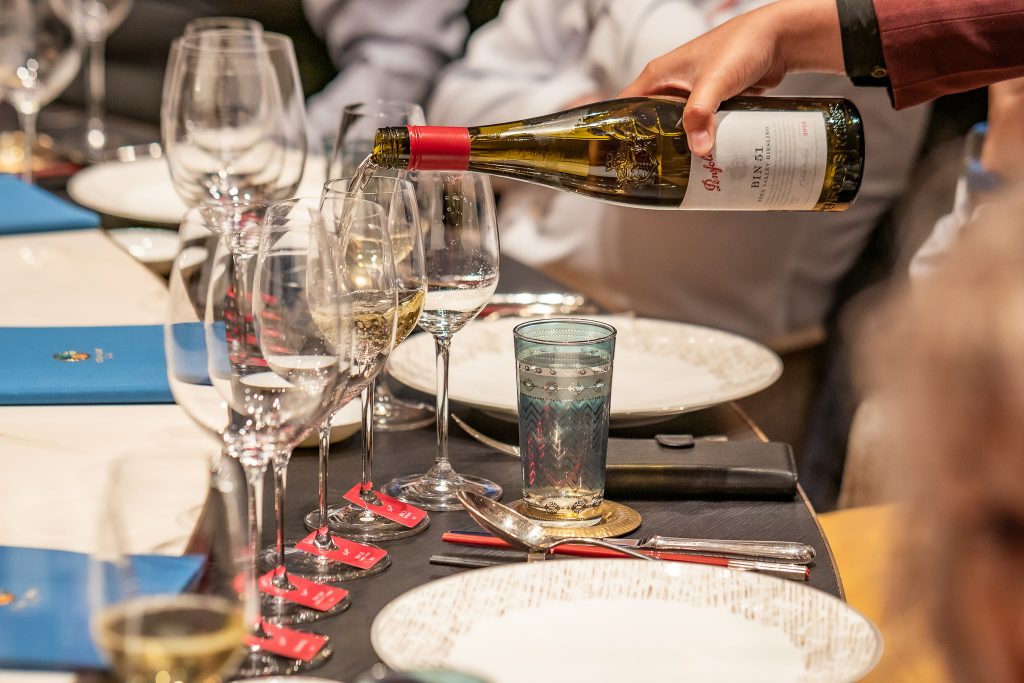
The Pairing with Szechuan Braised Abalone was an inspired choice, the intensity of the fruit in the wine and the acidity subduing the spices and contrasting nicely with the creamy, gelatinous texture of the dish, sublime.

The second wine was the Penfolds Bin 23, 2018, a Pinot Noir from the Adelaide Hills South Australia, Henty Victoria and Tasmania. This is a daring and exceptional wine from Penfolds, coming as it does from three different wine regions, in three different states. Pinot Noir can be the most fickle of varieties however, when it all goes right it is the stuff of vinous magic. The Bin 23 here shows aromas of wild strawberries, cranberry and fresh, field-mushrooms, with hints of violets, subtle wood spice and petrichor. The palate displays a wine with richness and depth of fruit, strawberry, Morello cherry, flavours with hints and accents of king oyster mushroom, five spice and a little game, adding further complexity. The wine is balanced nicely by some powdery tannins and lively acidity, giving vibrancy and freshness to the finish.
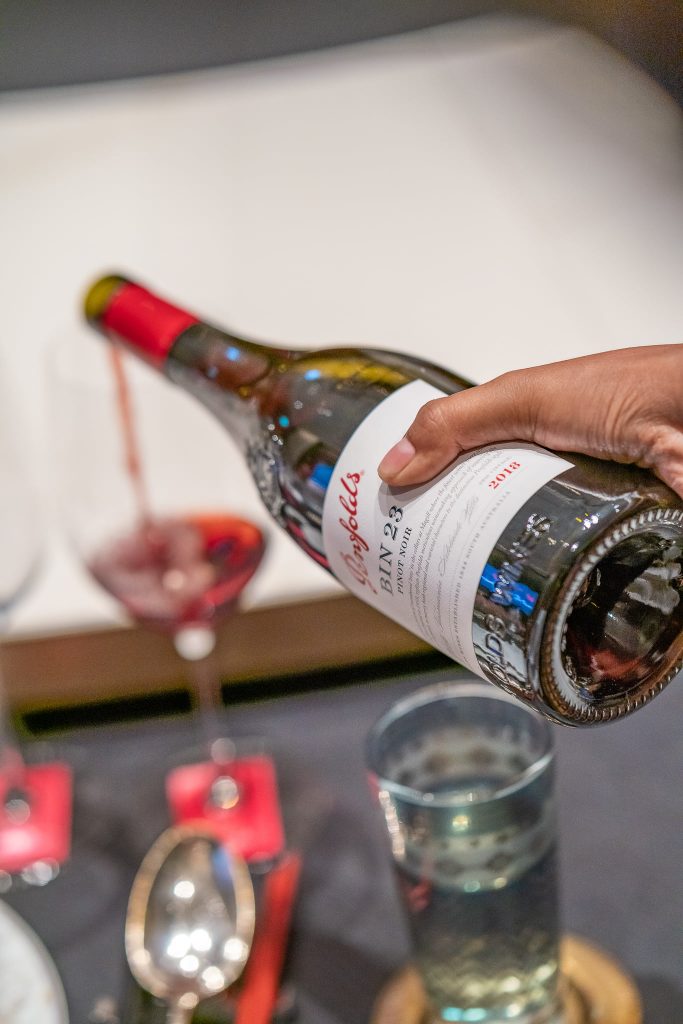
Served with tantalizing dim sum morsels, one a fluffy pastry with black pepper, fungus and foie gras at its core, the second a black and gold dumpling filled with pigeon and Mui Choy. This was a combination as intriguing, seductive and enchanting as the wine itself, another dazzling combination.

Now it was time to move into classic Penfolds’ territory, the full bodied and world famous Three Eight Nine. Penfolds Bin 389, 2018, a Cabernet Sauvignon / Shiraz blend from South Australia to be exact. Often referred to these days as ‘Baby Grange’ it was also once affectionately known as ‘Poor Man’s Grange’, because components of it are matured in the second-fill barrels that previously held ‘Grange’ when they were brand new. This 2018 wine is a blend of 57% Cabernet Sauvignon and 43% Shiraz, sourced from McLaren Vale, Barossa Valley, Padthaway, Coonawarra, Robe and Wrattonbully, all in South Australia. The wine was matured in American oak hogsheads, 38% of which were new and partially barrel fermented.

The wine has vibrant aromas of blackcurrant, plum and boysenberries with hints of toasted coconut and dark chocolate adding complexity. The palate is intense with a lavish depth of fruit and a creamy texture, yet it is not opulent, there is great finesse and elegance here. The texture leads way to fine, ripe, supple, and slightly dusty tannins and a gentle wash of acidity, there is impressive length on the palate and a lingering finish of attractive red fruits. The wine is an absolute stunner.
The pairing appeared challenging on paper, a double-boiled chicken soup with sea whelk and cordyceps, yet the match was as delightful as it was surprising, with the intensity and fatty texture of the broth holding its own against the depth and intensity of the fruit. The fine tannins, and a lick of acidity of the wine acting as counterpoint to the viscous richness of the broth.
Now we had reached the zenith of the dinner, the main course, and Penfolds most famous wine, one of the great wines of the world and one of the wine world’s most highly regarded.
Penfolds, Bin 95, Grange, 2014, Shiraz (98%) / Cabernet Sauvignon (2%), from the South Australian regions of the Barossa Valley, McLaren Vale, Wrattonbully, Clare Valley, and Magill Estate. The wine was aged for 20 months in 100% new American hogsheads and held in bottle for a further five years prior to its release.

2014 was a treacherous vintage for South Australian winemakers, testing their skills to the limits with most major regions having to contend with extreme weather conditions: frosts, high winds, and hail storms in spring; heatwaves late in the summer and untimely, rainfall in February. This has turned out a Grange that is as majestic and opulent as the greatest vintages but more open and generous in its youth than many.
Grange is released as a five-year-old wine, they normally don’t really hit their optimum drinking window for another five to ten years after that. Two years on from its release, this 2014 is drinking superbly. The colour is dense, opaque, with a vibrant purple/crimson halo. Aromas leap from the glass, soy, cola, hoi sin, dark plum, with hints of vanilla, smoky toasted coconut, coffee grinds, five spice and graphite.
On the palate, the wine is full-bodied but not a monster, there is a touch of elegance here, the fruit is expressive and there is some tertiary cold-tea notes along with flavours of mocha and blueberry, the texture is fine, silky, before grippy, slightly herbal, (sage) and even salty tannins kick in. This is a much more approachable and expressive Grange than the intense, impenetrable young Granges of the greatest vintages, it is drinking well now and is a beautiful introduction to this great wine’s charms and allure.
The main dish was an outstanding cut of Wagyu, Marble Score 6, served with black garlic and a hot bean, pepper sauce accompanied by lobster fried rice with beetroot, onion and asparagus. A magnificent dish and one fitting of being paired to one of the world’s finest full-bodied red wines.

The meal was finished with some purple gelatinous rice and coconut ice cream accompanied by some marvelous tea from Zhan Liang’s incredible tea library.
At the end of an organoleptically triumphant evening, I thanked our guests, thanked our magnificent hosts: Chhiv Timex Group, chef David Pang and Sommelier / Restaurant Manager Eden Gnean.
As we all basked in the glow of four glorious wines and a magnificent meal; I understood that each of us there had been brought a little closer to each other, closer than we were before. In a time of lock-downs and social distancing, we had been brought together by great gastronomy and fine wine and we were very grateful for it, we cherished it, able to appreciate just how special it was.
I reflect now on how the Chinese Lunar Calendar works on a 60-year cycle, how the first Grange was made 70 years ago, how the one we enjoyed this evening was the 64th consecutive vintage of the wine, how it had taken six years to arrive at our table and how one of our guests was celebrating a birthday that evening, the cycle of life.
I thought about time as a healer and of the rewards of patience.

Penfolds Wines are available in Cambodia through the Chhiv Timex Group.
